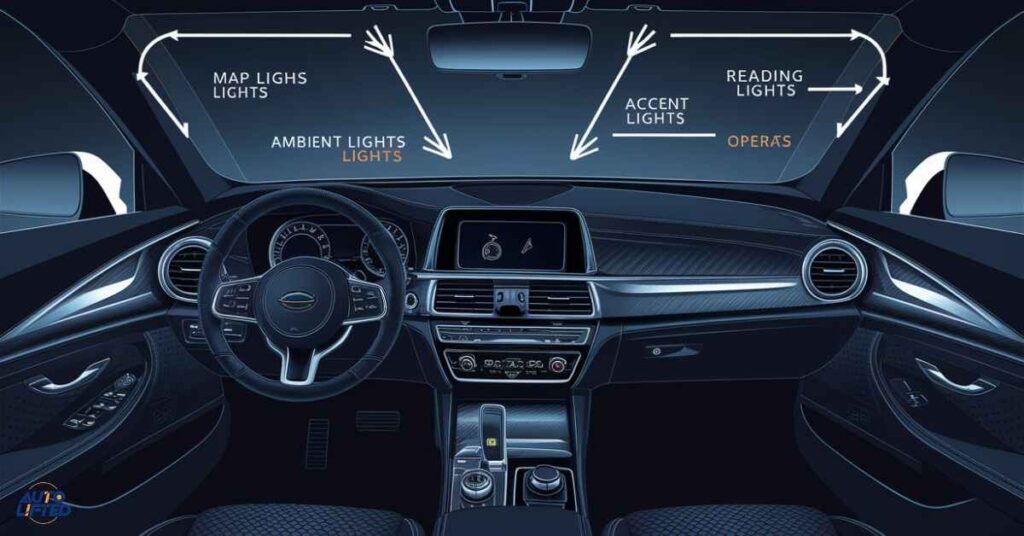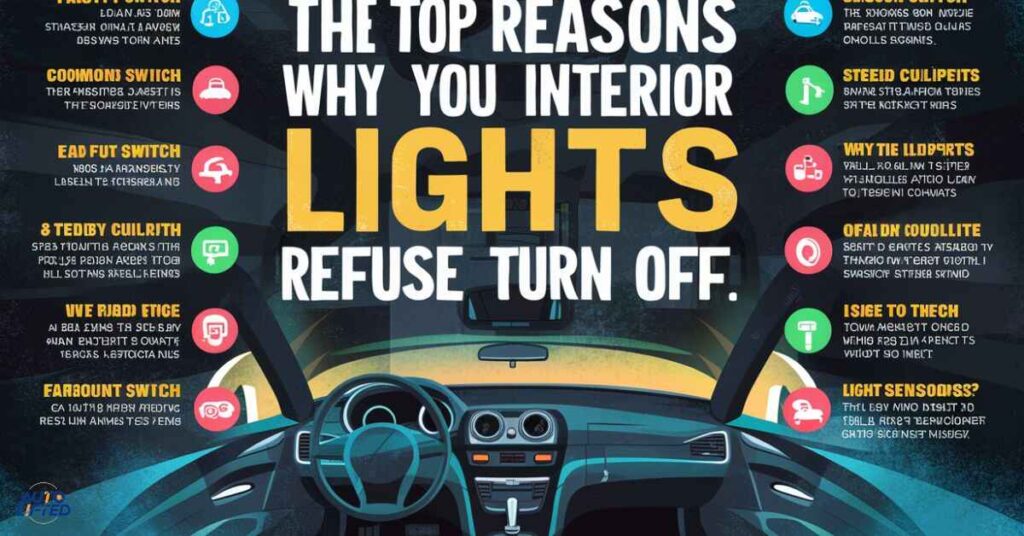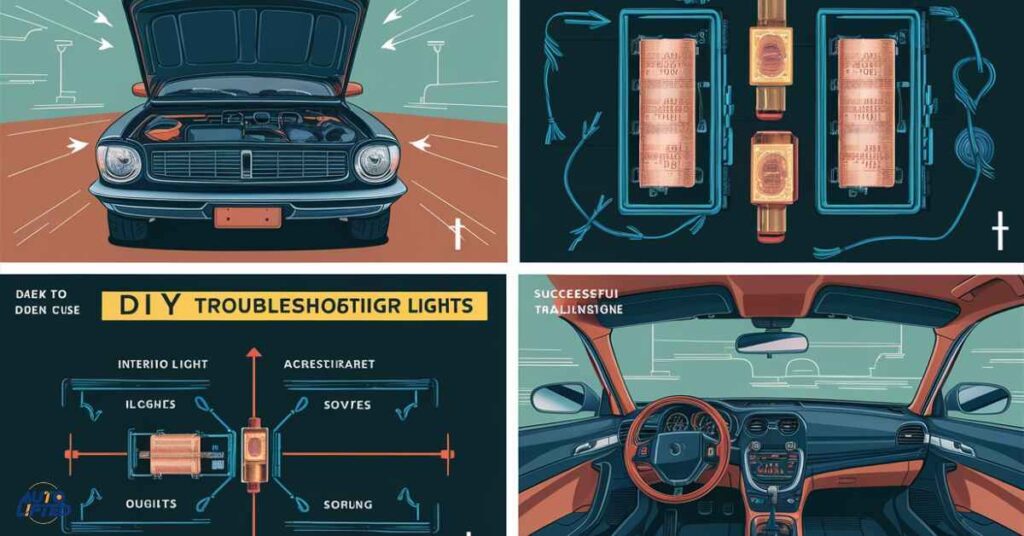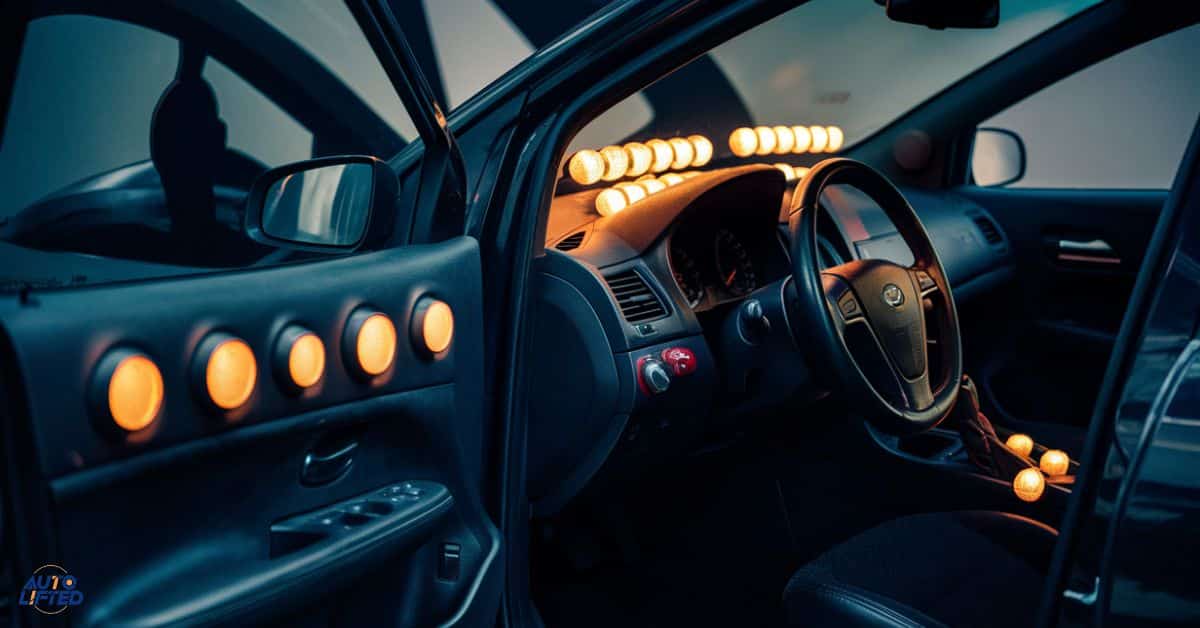Having trouble with your car’s interior lights not turning off. This common issue can drain your battery. It might be due to a stuck switch a malfunctioning door sensor or incorrect dimmer settings.
Sometimes, it is a wiring problem or a control module issue. Checking these components can help identify the cause. Fixing it promptly is important to avoid battery problems. In this guide, we will explain common reasons and how to troubleshoot them.
Understanding Your Car’s Interior Lighting System

Your car’s interior lighting system plays a crucial role in ensuring visibility and safety. While driving, especially during nighttime or low-light conditions.
This system comprises various types of lights strategically placed. The vehicle’s cabin and controlled by switches and automated programs for optimal operation. In modern vehicles, common interior lights include.
- Dome Light: This overhead light illuminates the cabin when doors open (via door-ajar switches) or can be manually operated. It provides overall interior illumination for easier entry/exit and visibility.
- Reading Lights: Also known as map lights, these are typically located on the overhead console near the rearview mirror or integrated into the sun visors. They allow the driver and passenger to read maps, books, or other materials without interfering with the driver’s vision.
- Trunk/Cargo Light: As the name suggests, this light turns on when the trunk or rear hatch is opened, illuminating the cargo area for better visibility when loading or unloading items. Some vehicles have a separate switch to control the trunk light.
Dashboard and Instrument Panel Lights:

- Warning Lights: These indicator lights alert the driver to potential issues, such as low coolant levels, brake problems, or other system malfunctions, requiring immediate attention.
- Indicator Lights: These lights provide information about the status of various vehicle systems, such as turn signals, headlights, and other operational indicators.
- Illumination Lights: These lights illuminate the dashboard and instrument panel, ensuring clear visibility of crucial gauges and displays during nighttime driving.
The interior lighting system is designed to operate automatically. With lights turning on and off based on specific triggers. As opening or closing doors, activating the headlight switch, or reaching a predetermined time delay.
Read This Blog: Is
It Illegal To Have Led Lights Inside Your Car
However, issues can arise that cause these lights to remain on. They should be off, leading to unnecessary battery drain and potential starting problems.
Top Reasons Why Your Car’s Interior Lights Won’t Turn Off

Several factors can contribute to your car’s interior lights. Refusing to turn off, potentially draining your battery over time. Here are some of the most common reasons why this issue may occur.
1. The Door Switch is Faulty
Door switches play a critical role in controlling when interior lights turn on and off. The door’s open or closed state. When a door is opened, the switch is activated, triggering the lights to turn on.
Conversely, when the door is closed, the switch should deactivate. Allowing the lights to turn off after a brief delay.
However, if a door switch becomes faulty or broken, it may remain stuck in the “open” position, tricking the system into thinking a door is still ajar. As a result, the interior lights will remain on, even after all doors have been closed securely.
Signs of a faulty door switch:
- Interior lights stay on after closing all doors
- No audible “click” sound when operating the switch
- Interior lights don’t respond to the switch’s operation
2. The Dimmer Switch is Set Improperly
Many modern vehicles are equipped with a dimmer switch, typically a thumbwheel or a dial, located on the dashboard or near the steering column.
This switch allows the driver to adjust the brightness level of the dashboard and instrument panel lights, providing optimal visibility without causing excessive glare or eye strain.
However, if the dimmer switch is set too high, it may prevent the dome light or other interior lights from turning off completely. This issue can occur if the switch was inadvertently rotated. Its maximum setting or if there is a malfunction in the dimmer switch itself.
3. A Manual Light Switch Was Left On
While most interior lights are designed to operate automatically. Many vehicles also include manual switches that allow the driver or passengers to override the automatic system. These switches can be found in various locations, such as.
- Overhead dome light switch
- Dash-mounted switch
- Door light switches
If any of these manual switches are accidentally left in the “ON” position. The corresponding interior lights will remain illuminated, regardless of the door or switch positions. It is essential to double-check all manual light switches. Ensure they are in the correct position to prevent this issue.
4. Wiring Issues or Failed Control Module
In some cases, the reason behind interior lights not turning off may be related to underlying electrical issues. within the vehicle’s wiring system or a malfunctioning control module responsible for managing the interior lighting system.
Damaged wiring, such as frays, shorts, or disconnects, can disrupt the flow of electrical signals, causing the lights to behave erratically or remain on constantly. Additionally, a failed control module, which acts as the brain of the lighting system, can lead to inconsistent or improper operation of the interior lights.
Also Read This Blog:
What Cars Have Ambient Lighting
Signs of wiring issues or control module failure:
- Interior lights stay on despite checking all switches and settings
- Lights exhibit inconsistent or erratic behavior
- Other electrical issues or warning lights are present
DIY Troubleshooting Steps for Interior Lights

If you are experiencing issues with your car’s interior lights not turning off. There are several DIY troubleshooting steps. You can take before seeking professional assistance.
These steps involve inspecting various components of the lighting system. Performing simple tests to identify the root cause of the problem. Follow these steps carefully.
1. Inspecting Door Switches
The door switches are often the first culprit to investigate when interior lights refuse to turn off. Here’s how you can inspect and test these switches:
- Locate the door switches, which are typically situated in the door jambs (the area where the door meets the vehicle body).
- Operate each door switch by opening and closing the respective door. When functioning correctly, you should hear and feel a distinct “click” sound, and the interior lights should respond accordingly (turning on when the door is opened and off when closed).
- Use a multimeter or a test light to check for continuity across the switch terminals when the switch is pressed. If there is no continuity, it indicates a faulty switch.
If a door switch fails any of these tests, it likely needs to be replaced. Consult your vehicle’s repair manual for the specific replacement procedure and any additional steps required.
2. Adjusting the Dimmer Switch
If the issue seems to be related to the dimmer switch, follow these steps:
- Locate the dimmer switch, typically a knob or dial on the dashboard or near the steering column.
- Rotate the dimmer switch through its entire range of positions, carefully observing the behavior of the dome light or other interior lights.
- If the lights turn off at a certain dimmer setting, note that position, and adjust the switch accordingly to resolve the issue.
- However, if the dome light or other interior lights remain on regardless of the dimmer switch position, the switch itself may be faulty and require replacement or bypassing to shut the lights off temporarily.
3. Testing Manual Light Switches
If you suspect that a manual interior light switch may have been left in the “ON” position, follow these steps:
- Identify all manual interior light switches in your vehicle, which may be located overhead, on the dashboard, or on the door panels.
- Cycle each switch from the “ON” to “OFF” position and vice versa, carefully observing the response of the corresponding interior lights.
- If a particular switch appears stuck or non-functioning, it may need to be replaced to restore proper operation.
4. Checking Wiring and Fuses
Electrical issues, such as damaged wiring or blown fuses, can also contribute to interior lights not turning off correctly. Here’s how you can inspect the wiring and fuses:
- Visually inspect the wiring harnesses in areas where they may be prone to damage, such as door jambs, the trunk area, and the overhead console. Look for any signs of fraying, cuts, or disconnections.
- Use a test light to check for shorts or breaks in the lighting circuit wiring. Consult your vehicle’s wiring diagram to identify the appropriate wires to test.
- Locate the fuse box(es) in your vehicle and identify the fuse(s) responsible for the interior lighting system. Check for any blown fuses using a test light or by visually inspecting the fuse element.
- If you find a blown fuse, replace it with a new fuse of the correct amperage rating, as specified in your owner’s manual or on the fuse box cover.
Warning: If you experience repeated fuse blowouts, it may indicate an underlying wiring short or more severe electrical issue that requires professional diagnosis and repair.
When to Call a Professional

While many interior lighting issues can be diagnosed and potentially resolved through DIY troubleshooting, there are certain situations where seeking professional assistance from a certified auto technician is advisable:
- Failed Control Module: If you suspect that the issue lies within the control module responsible for managing the interior lighting system, it may require specialized replacement procedures best handled by
Warning: If you experience repeated fuse blowouts, it may indicate an underlying wiring short or more severe electrical issue that requires professional diagnosis and repair.
When to Call a Professional
While many interior lighting issues can be diagnosed and potentially resolved through DIY troubleshooting, there are certain situations where seeking professional assistance from a certified auto technician is advisable:
- Failed Control Module: If you suspect that the issue lies within the control module responsible for managing the interior lighting system, it may require specialized replacement procedures best handled by a professional. Control modules are often integrated into the vehicle’s computer systems, and improper handling can lead to further complications.
- Repeated Interior Light Problems After DIY Fixes: If you’ve attempted DIY troubleshooting steps but continue to experience recurring issues with your interior lights not turning off, it may be an indication of a more complex underlying problem. A professional technician has the expertise and diagnostic tools to pinpoint and resolve persistent issues effectively.
- Extensive Wiring Damage or Corrosion: In cases where the wiring harnesses or connectors show signs of significant damage, corrosion, or widespread issues, it is generally recommended to seek professional assistance. Attempting to repair or replace extensive wiring components can be a complex and time-consuming task, and improper repairs can lead to further electrical problems.
A certified auto technician has the specialized knowledge, tools, and experience to efficiently diagnose and fix stubborn vehicle lighting system faults, saving you time and potential frustration.
They can also identify and address any underlying issues that may have contributed to the problem, preventing future occurrences.
Tips for Preventing Future Problems
While addressing the immediate issue of interior lights not turning off is crucial, it’s also important to take preventive measures to avoid similar problems in the future. Here are some tips to help maintain your vehicle’s interior lighting system:
- Develop Good Habits: Establish a routine of doing a final light check before exiting your car. This simple habit can help you catch any accidentally left-on manual light switches or other potential issues before they drain your battery.
- Periodic Inspections: Regularly inspect the door switches, wiring harnesses, and connections for any signs of wear, damage, or corrosion. Addressing these issues early can prevent more significant problems from developing.
- Consider Annual Maintenance: Incorporate professional inspections and maintenance into your annual service routine. Certified technicians can identify and address emerging issues with your vehicle’s electrical systems, including the interior lighting system, before they become major problems.
By following these preventive measures and addressing any issues promptly, you can help ensure the longevity and proper functioning of your car’s interior lighting system, enhancing visibility, safety, and overall electrical system health.
Frequently Asked Question
Why are my inside lights staying on in my car?
Your inside lights might stay on if a door is not closed properly, a door switch is broken, or the dimmer switch is set to the highest setting.
Why is my interior car light not turning off?
The interior light might not turn off due to a malfunctioning door sensor, a control knob being activated, or issues with the wiring or control modules.
How do I turn off the lights inside my car?
To turn off the interior lights, check that all doors are properly closed, ensure the light switch is set to off and adjust the dimmer switch if necessary.
Why won’t the light in my car turn off?
If the light won’t turn off, it could be due to a broken door switch, a misadjusted dimmer, or a control knob being left on.
Why are my lights still on when I turn them off?
Lights might stay on due to a faulty door switch, an incorrectly set control knob, or issues with the car’s wiring.
What happens when all the lights stay on in your car?
When all the lights stay on, it can drain the car’s battery, potentially leaving you unable to start the car and causing other electrical issues.
Conclusion
Interior lights that refuse to turn off can be more than just an annoyance. they can drain your car’s battery, potentially leaving you stranded and in need of a jump-start or a costly battery replacement.
This comprehensive guide has covered the common causes behind interior lights not turning off. Faulty door switches, improper dimmer settings, stuck manual light switches. Underlying wiring or control module issues.
By following the step by step DIY troubleshooting advice provided, many interior lighting problems. Can be diagnosed and repaired at home with basic tools and some technical knowledge.
However, it is important to recognize when professional assistance from a certified auto technician. It is necessary, particularly in cases of complex electrical system faults or extensive wiring damage.
Preventive habits, such as double checking light switches before exiting the vehicle, periodic inspections of wiring and connections. Incorporating professional maintenance into your annual service routine. A long way toward avoiding inconvenient breakdowns caused by a drained battery due to interior lights left on.
Remember, your car’s interior lighting system plays a crucial role in ensuring visibility, safety, and overall electrical system health.
By prioritizing its proper functioning and addressing any issues promptly. You can enjoy a well lit and reliable driving experience, day or night.
